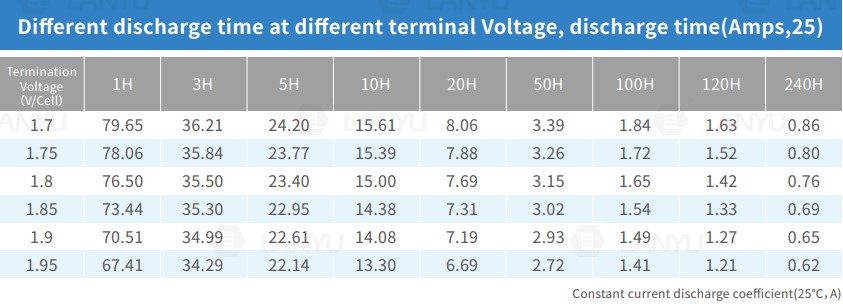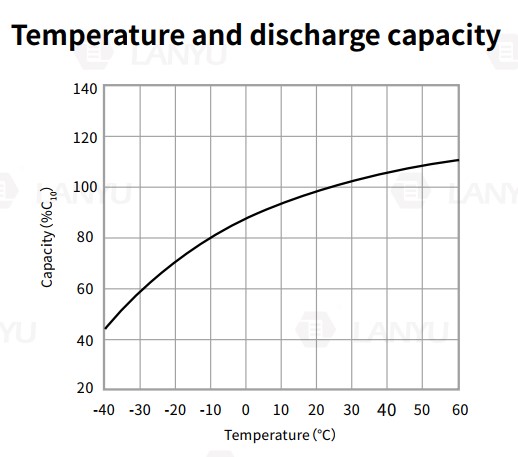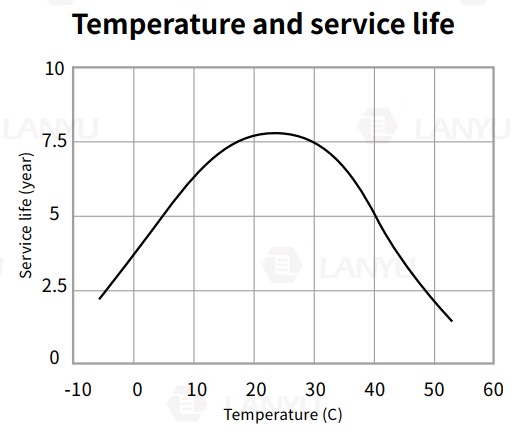Choosing the right lead acid battery capacity is very important to have better usage of the solar system or backup power system. The selection of lead acid battery capacity is based on your needs of the application, voltage, discharge time, and temperature. This article will introduce how to choose lead acid battery capacity.
The lead acid battery capacity is related to the battery charge and discharge current: the current increases, the lower the battery capacity; the smaller the current, the higher the battery capacity. Battery discharge current and capacity have the relationships follow the Peukert equation:
- C = I n · t
- C – Capacity (Ah)
- I – Current (A)
- t – Time (sec, min, or hour)
- n – Constant value
Following is an example of lead acid battery capacity selection in constant current discharge conditions:
Requirement:
Load current of 20A
Normal running voltage is DC48V ± 15% 10% 0 °C
Can work last 5 hours (minimum).
The basic calculations are as follows:
The maximum DC bus voltage U max = 48 × 1.15 = 55.20V
The minimum DC bus voltage U min = 48 × 0.90 = 43.20V
If you use the monomer voltage of the 12-volt lead acid battery, U max ÷ 2.25 (float voltage) = 55.20 ÷ 13.8Vpc, = 4, the total need is about 4pcs.
Minimum discharge voltage U min ÷ 4 = 43.20 ÷ 4 = 10.8Vpc only.
If the temperature is 25 ℃, the factory battery specification table shows that: when the cell discharge termination voltage of 1.8V (one battery have 6 cell inside), the DC-150 type battery’s 5-hour rate discharge current is 23.4A.

However, the required use of a temperature of 0°C! Should be carried out in accordance with the manual given formula and the correction factor correction:

However, the required use of a temperature of 0°C! Should be carried out in accordance with the manual given formula and the correction factor correction:
The discharge capacity required by: Ct = 20A × 5h = 100Ah
Correction factor: K = 0.018
Capacity after correction: C e = 100 × [1 +0.018 × (0 – 25)] = 182Ah
Requirements of the discharge current (25 ° C, and 5-hour rate): I d = 182 ÷ 5 = 36A
Clearly, DC-150 batteries cannot meet the requirements. The factory battery specification table shows that: the DC-200 battery 5-hour rate discharge current of 36A, seems to meet the requirements.
But if you need a lead acid battery that can reliably support the system in the entire life span should also be considered in the selection of the battery end-of-life provisions: 80% less than the rated capacity of the battery discharge when means the end-of-life.

So the actual discharge capacity should be:
C = 182Ah × 120% = 218Ah
25° C when the discharge current (5-hour rate): I = 218/5 = 43.6A
From the factory battery specification table shows that: when the discharge termination voltage of 1.8V, GFM-250 type battery 5-hour rate discharge current of 45A, to meet the requirements.
Final correct selection of the battery results: 4pcs DC-250 type batteries.




